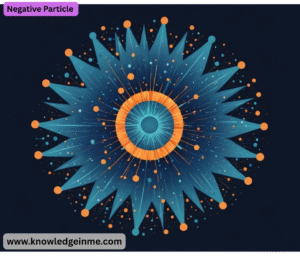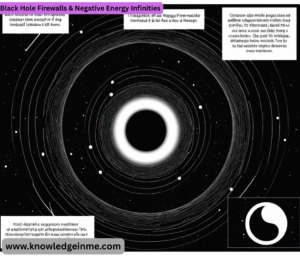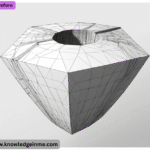Negative Particle Negative Particle In physics, a negative particle typically refers to a particle with a negative electric charge, such as:
- Electron (e⁻) – A fundamental particle with a charge of -1 e (where *e* is the elementary charge).
- Tau (τ⁻) – An even heavier charged lepton.
- Antiprotons – The antiparticle of the proton, carrying a charge of -1 e.
- Negative ions – Atoms or molecules that have gained extra electrons, giving them a net negative charge (e.g., Cl⁻, OH⁻).
Negative Particles in Different Contexts:
- Electromagnetism: Negative particles are attracted to positive charges and repelled by other negative charges.
- Antimatter: Some negatively charged particles (like positrons, e⁺, are positive, but antiprotons are negative).
Composite Negative Particles Ions & Quarks
- Negative Ions: Atoms/molecules with extra electrons (e.g., O₂⁻, Cl⁻, H⁻).
- Important in plasma physics, electrochemistry, and biological processes.
- Quarks: While not isolated, some quarks have fractional negative charges:
- Down quark (d): Charge = -1/3 e
- Strange quark (s): Charge = -1/3 e
- Bottom quark (b): Charge = -1/3 e
Roles in Physics
Electromagnetism
- Negative particles attract positive charges (Coulomb’s law:
- Electric current in metals is the flow of electrons (e⁻).
Quantum Mechanics
- Fermions (like e⁻) obey the Pauli exclusion principle (no two identical fermions can occupy the same quantum state).
- Antiparticles: For every particle (e.g., e⁻), there’s an antiparticle (e⁺).
Antimatter & Particle Physics
- Antiprotons (p̄) are produced in high-energy collisions (e.g., at CERN).
- Positronium: A bound state of e⁻ and e⁺ that annihilates into photons.
Astrophysics & Cosmology
Cosmic rays contain high-energy μ⁻ and π⁻.
Interesting Phenomena
- Beta decay (β⁻): A neutron → proton + e⁻ + antineutrino.
- Cathode rays: Streams of e⁻ in vacuum tubes (old TVs, CRT monitors).
- Negative ion beams: Used in particle accelerators and medical therapies.
Open Questions & Research
- Why is there more matter than antimatter? (Cosmological asymmetry problem)
- Do negatively charged exotic particles exist? (Beyond Standard Model)
- Can we trap antimatter (e⁻ + p̄) for long-term study? (CERN’s ALPHA experiment)
Exotic Negative Particles Beyond the Standard Model
- While the Standard Model explains known negative particles, several hypothetical ones could exist:
Magnetic Monopoles with Negative Charge
- Predicted by Grand Unified Theories (GUTS) and string theory.
- A “monopole” would carry isolated magnetic charge, but some models suggest they could also have electric charge (e.g., negatively charged magnetic monopoles).
- If discovered, they’d revolutionize electromagnetism.
Charged Dark Matter Candidates
- Some dark matter theories propose milli-charged particles (tiny fractional charge, e.g., -0.001 e).
- Could interact weakly with photons, making them detectable in underground experiments (DAMIC, SENSEI).
Sterile Neutrinos with Electric Charge?
- Standard neutrinos are neutral, but some extensions suggest charged heavy neutrinos (e.g., τ-neutrino⁻).
- Could explain neutrino mass and matter-antimatter asymmetry.
Negative Particles in Extreme Environments
Inside Neutron Stars
- At ultra-high densities, protons may convert into negative muons (μ⁻) due to Fermi pressure.
- This creates muonic matter, altering neutron star cooling rates.
Black Hole Electrodynamics
- Near rotating (Kerr) black holes, Penrose processes could extract energy by splitting particles into:
- One falling in (negative energy)
- One escaping (high energy)
- Hypothetical negatively charged black holes could exist in some theories.
Quark-Gluon Plasma (QGP)
- Strangelets (hypothetical chunks of strange quark matter) could be negatively charged.
Negative Antimatter: The Unsolved Puzzle
- Antimatter particles can also be negatively charged (e.g., antiprotons, antimuons). But:
- Why does the universe favor matter? (CP Violation)
- Does antimatter fall up or down? (ALPHA-g experiment at CERN tests if antiprotons “fall” in gravity).
- Can we make bulk antimatter? (Currently, only a few hundred antihydrogen atoms have been trapped.)
Negative Particles in Technology & Future Applications
Antimatter Propulsion
- NASA’s conceptual designs (e.g., ICAN-II) propose storing antiprotons to fuel Mars missions.
Quantum Computing with Trapped Ions
- Negative ions (e.g., Ca⁻, Be⁻) are used in ion-trap quantum computers due to long coherence times.
Negative Mass & Exotic Matter
Alcubierre Warp Drive & Negative Energy
- Einstein’s equations allow for “exotic matter” with negative mass (or negative energy density).
- Such matter could theoretically warp spacetime (Alcubierre drive), enabling faster-than-light travel.
Dark Energy & Repulsive Gravity
If dark energy has negative pressure, it could explain the universe’s accelerating expansion.”
Time Crystals & Negative Temperature States
- Certain quantum systems (e.g., trapped ions) can exhibit negative absolute temperatures, where entropy decreases with energy.
- Could such systems stabilize exotic negative-mass particles?
Quantum Electrodynamics (QED) at the Edge
Schwinger Effect: Pair Production from Nothing
- In extreme electric fields (~10¹⁸ V/m), the vacuum spontaneously generates e⁻ e⁺ pairs (Schwinger mechanism).
- Could this be engineered in graphene or quantum dots?
Supercritical Charges & Collapsing Atoms
- If an atomic nucleus exceeds Z ≈ 170, the 1s electron’s energy becomes negative (diving into the Dirac sea).
- Theoretically, this could create a “charged vacuum”—a new state of matter.
Electrons Splitting into “Quasiparticles”
- In fractional quantum Hall systems, electrons behave like composite fermions with fractional charge (e.g., e/3).
- Could there be fundamental particles with fractional charge?
Black Hole Firewalls & Negative Energy Infinities
Hawking Radiation & Negative Energy Partners
- When a black hole radiates (Hawking radiation), one particle (e⁻) escapes, while its negative-energy partner falls in, reducing the black hole’s mass.
- Does this imply a “firewall” of high-energy particles at the event horizon?
ER = EPR: Are Wormholes Made of Entangled e⁻ e⁺ Pairs?
- Maldacena & Susskind’s conjecture: Einstein-Rosen bridges (wormholes) are built from entangled particles.
- Could we “teleport” information using negative-energy electrons?
The Neutrino Charge Anomaly
If true, this would break the Standard Model—are neutrinos secretly negative particles?
The Ultimate Mystery: Why Does Charge Quantization Exist?
- Why not 0.37e?
- Some theories (e.g., magnetic monopoles) explain this, but none are confirmed.
3. Negative Temperatures & Inverted Thermodynamics
A. Absolute Zero is Not the Coldest Temperature
- In certain quantum systems (e.g., lasers, spin systems), negative absolute temperatures are possible.
Bizarre Effects:
- Heat flows from cold to hot.
- Entropy decreases as energy increases.
- Could a “negative-temperature electron” defy the 2nd Law of Thermodynamics?
B. Perpetual Motion Machines?
- A negative-temperature system coupled to a positive one could, in theory, extract infinite energy.
- Why doesn’t this violate physics? (Spoiler: It does, unless carefully constrained.)
4. The Black Hole Electron Hypothesis
A. What if Electrons are Mini Black Holes?
- If an electron were compressed to its Schwarzschild radius (~10⁻⁵⁷ m), it would become a quantum black hole.
- Problem: This is 23 orders of magnitude smaller than the Planck length.
- Loop Quantum Gravity Alternative: Maybe electrons are “fuzzballs” with no singularities.
5. The Holographic Electron: Is Charge an Illusion?
A. Ads/CFT Correspondence & Emergent ChargeIn
- holographic duality, a 3D electron could be a projection of a 2D surface.
B. Quantum Hair & Information Storage
- Recent work suggests black holes may have “quantum hair” encoding information.
- Could electrons also store hidden information in their “hair”?
6. The End of Physics? Undiscovered Conservation Laws
A. Charge Non-Conservation in Neutron Stars
- Some theories predict proton decay (p → e⁺ + π⁰), which would violate charge conservation.
- Do neutron stars secretly eat protons, leaving behind a sea of electrons?






